GRAY WHALES ARE HEADING TO MONTEREY BAY ON THEIR ANNUAL MIGRATION – WINTER/SPRING
As the days become colder and fall changes to winter, here in Monterey Bay we notice the seasonal change by the animals that arrive for winter and those that depart. Monarch butterflies arrive to their sanctuary in Pacific Grove to overwinter; a variety of birds such as loons, grebes, and ducks leave their northern breeding grounds to spend the winter in Monterey Bay. Millions of shearwaters, seabirds that never go to land except to mate and raise their young, spend summer and fall feeding in our rich waters then migrate down to New Zealand and Chile to reproduce. Arctic terns have all passed by Monterey Bay from the Arctic Ocean on their way to Antarctica for their continual summer. Humpback and Blue Whales head to their wintering areas off Mexico and Central America after gorging on the abundance of krill and fish during their summer and fall feeding season off Monterey.
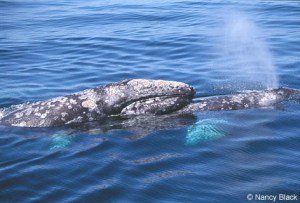
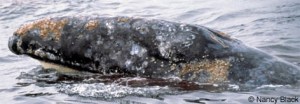
However, the most anticipated animal that arrives predictably to Monterey Bay every year in early winter is the Gray Whale. At 45′ long and 45 tons, Gray Whales are magnificent mammals that represent a tremendous success story. At one time nearly hunted to extinction with just a few hundred whales left, they now number over 23,000 and were taken off the endangered species list in 1994. This year we are celebrating 10 full years since the Gray Whale was removed from the endangered list. No other whale has yet reached such pre-whaling numbers, but hopefully given more time the other endangered whales will match the success of Gray Whales.
Every year the Grays depart from their summer feeding grounds in the Arctic on their way to their winter breeding grounds off Baja, Mexico. Hundreds of whales stream past the coast of Monterey during their journey; at 6,000 miles one way, it’s the longest known migration for any mammal.
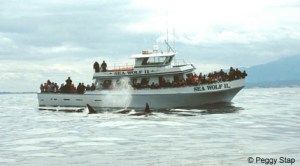 Gray Whales pass very close to shore just off Monterey after crossing the deep Monterey Submarine Canyon, the Grand Canyon of the ocean. Since they prefer shallow waters during their migration, the whales concentrate very close to the coast after crossing the canyon. Monterey Bay also supports a variety of other marine mammals during the winter. Often thousands of dolphins frolic in the Bay feeding on fish and squid. Killer Whales occasionally cruise along the canyon edge in search of marine mammal prey, and sea lions, harbor seals, and sea otters are a daily treat. Occasionally, the sperm whale, denizen of the deep, feeds over the canyon.
Gray Whales pass very close to shore just off Monterey after crossing the deep Monterey Submarine Canyon, the Grand Canyon of the ocean. Since they prefer shallow waters during their migration, the whales concentrate very close to the coast after crossing the canyon. Monterey Bay also supports a variety of other marine mammals during the winter. Often thousands of dolphins frolic in the Bay feeding on fish and squid. Killer Whales occasionally cruise along the canyon edge in search of marine mammal prey, and sea lions, harbor seals, and sea otters are a daily treat. Occasionally, the sperm whale, denizen of the deep, feeds over the canyon.
People can view these migrating Gray Whales from boats and shore as they pass by in groups of 2 to 10 then raise their tail flukes for a 2-5 minute dive, travelling at a rate of 3-4 miles an hour. It takes the Grays from 2 to 2.5 months of constant travel from Alaska to reach their breeding destinations off Baja, California. After mating and calving in the shallow protected lagoons of Baja they begin the long journey back to Alaska again for the summer feeding season, passing by Monterey Bay again during late winter and spring. The migration is very dispersed by sex and age class, so not all the whales leave Alaska or Mexico at the same time. Therefore, in Monterey Bay we can observe the Gray Whales daily from December through April. By April, the first Humpback Whales arrive to the Bay for their long feeding season.
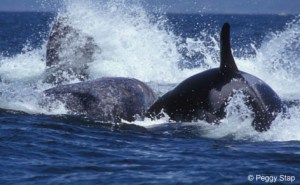
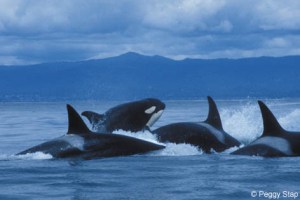 During the Grays’ northbound migration past Monterey Bay, Killer Whales are searching for the Gray Whale calves that are born during January in Mexico and travel with their mothers past Monterey Bay during spring on their way to Alaska. The mothers and calves are the last whales to leave their protected lagoons and pass Monterey nearly a month after the peak of the adult Gray Whales. The mothers and calves closely hug the coast as they travel north. When the whales reach Monterey Bay they generally cross the Bay and the deep submarine canyon where their migration path crosses the deep-water habitat of the Killer Whales. The Killer Whales patrol the canyon edges in search of the Gray Whale calves. When a Gray Whale calf is located, one of the greatest predation events on earth occurs — several 5-ton Killer Whales battling a 45-ton Gray Whale mother and her 10-ton calf for up to six hours. If successful the Killer Whales gain a rich and abundant source of food for over 20 whales.
During the Grays’ northbound migration past Monterey Bay, Killer Whales are searching for the Gray Whale calves that are born during January in Mexico and travel with their mothers past Monterey Bay during spring on their way to Alaska. The mothers and calves are the last whales to leave their protected lagoons and pass Monterey nearly a month after the peak of the adult Gray Whales. The mothers and calves closely hug the coast as they travel north. When the whales reach Monterey Bay they generally cross the Bay and the deep submarine canyon where their migration path crosses the deep-water habitat of the Killer Whales. The Killer Whales patrol the canyon edges in search of the Gray Whale calves. When a Gray Whale calf is located, one of the greatest predation events on earth occurs — several 5-ton Killer Whales battling a 45-ton Gray Whale mother and her 10-ton calf for up to six hours. If successful the Killer Whales gain a rich and abundant source of food for over 20 whales.
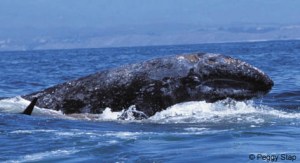

Although this is a yearly event, last spring (2004) our research team led by marine biologist Nancy Black documented an unprecedented event, as far as the frequency of Killer Whale sightings and the number of attacks and feeding events on Gray Whales. After several years of relatively low numbers of Gray Whale calves and a significant decrease in the Gray Whale population, the number of calves born in 2004 was the highest since counts by the National Marine Fisheries Service began 10 years ago. Wayne Perryman, who heads these counts, believes that more calves survive through full term and are successfully nursed during years when whales have an abundant and predictable food source in the Bering Sea, which occurred during the summer of 2003. Last spring, many calves passed through the Bay each day, with a peak of around 40 mother/calf pairs per day compared to less than 10 in previous years.
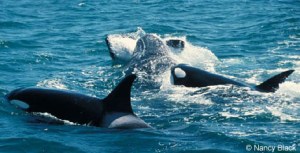
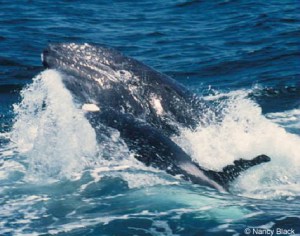
From April through mid-May, we documented 65 different Killer Whales involved in at least 16 attacks on Gray Whale calves (including four escapes by the Grays), compared to just a few attacks over the last six years. The usual group sizes for transient Killer Whales average 3 to 8 whales but during the spring season several of these core or family groups gathered together in a coordinated effort to hunt the Gray Whales and share the food. Reproductively active females were most involved in the attacks. At least 13 different core groups were found over this period and four groups were present nearly 50% of the days while some groups occurred just one or two times. It was surprising that some groups were involved so frequently and we wondered if they were binge feeding by taking advantage of this huge food source over a short period of time. In addition, another function of pursuing Gray Whales is for adult female Killer Whales to teach their young how to hunt, as a great deal of learning, cooperation and communication is required to take down such a large animal.

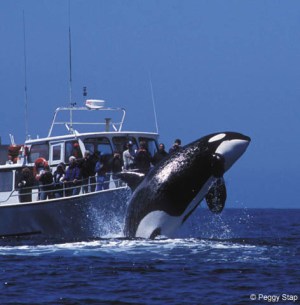 With such a high diversity of marine mammals inhabiting Monterey Bay, its not surprising that transient Killer Whales frequent this area year-round. Over the last 17 years we have identified over 150 different transient whales based on distinct markings and have documented association patterns, calving rates, behavior, and long range movements. Although Killer Whale occurrence is unpredictable, and the whales are sighted 2 to 8 times per month, they are frequently seen in Monterey Bay during the spring, corresponding to the migration of mother Gray Whales and their calves. We hope to continue monitoring the Killer Whales over many more years and as a keystone species these whales act as health indicators for the marine environment.
With such a high diversity of marine mammals inhabiting Monterey Bay, its not surprising that transient Killer Whales frequent this area year-round. Over the last 17 years we have identified over 150 different transient whales based on distinct markings and have documented association patterns, calving rates, behavior, and long range movements. Although Killer Whale occurrence is unpredictable, and the whales are sighted 2 to 8 times per month, they are frequently seen in Monterey Bay during the spring, corresponding to the migration of mother Gray Whales and their calves. We hope to continue monitoring the Killer Whales over many more years and as a keystone species these whales act as health indicators for the marine environment.
Monterey Bay Whale Watch offers daily 3 hour trips to observe these whales and dolphins. All our trips are led by marine biologists and departs from Fisherman’s Wharf in Monterey, call for info or reservations at 831-365-4658 or go to www.gowhales.com where you can reserve online.
